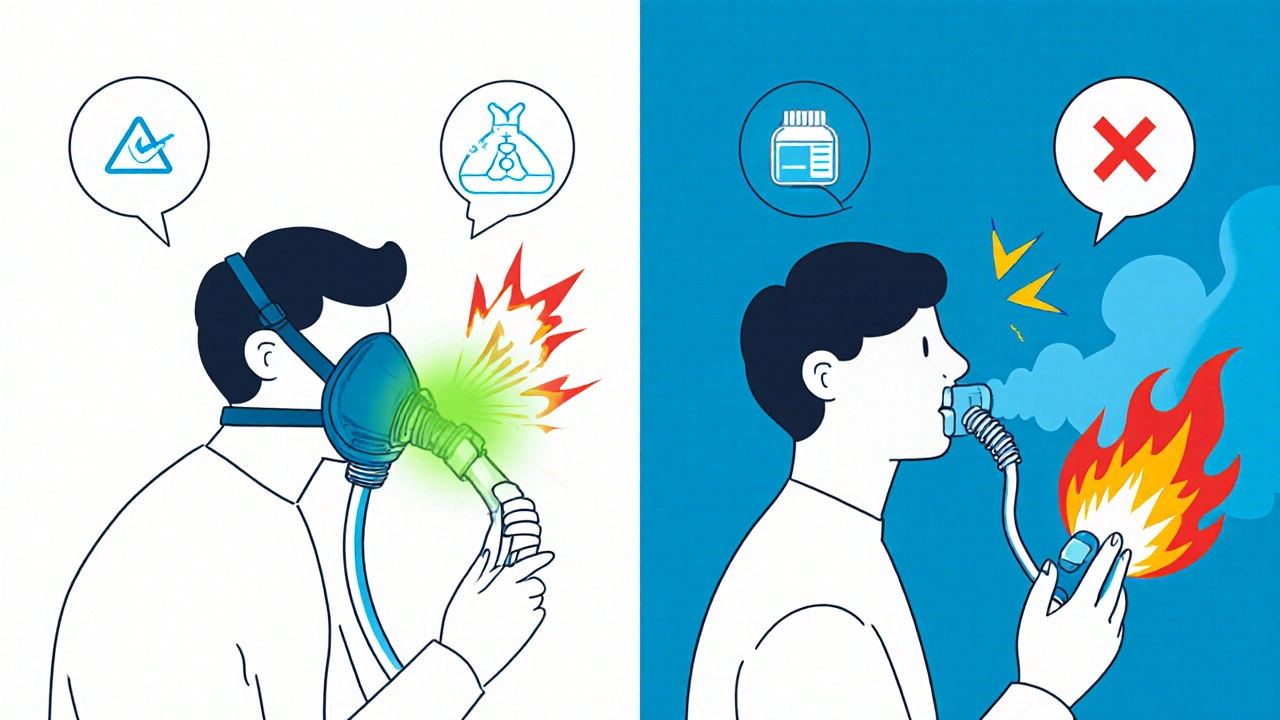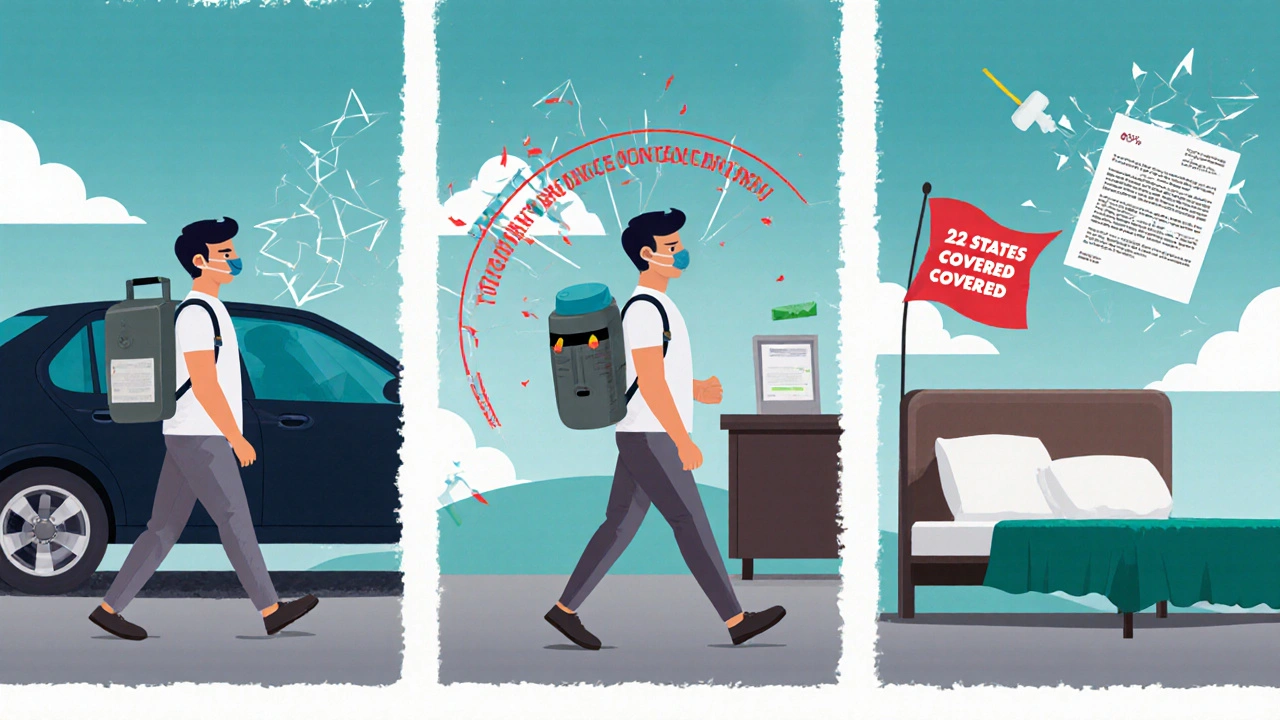Cluster Headaches: Severe Pain and Oxygen Therapy
 Nov, 17 2025
Nov, 17 2025
What Are Cluster Headaches?
Cluster headaches are not just bad headaches-they’re among the most painful conditions known to medicine. People who experience them describe the pain as a burning, drilling, or stabbing sensation behind one eye or on one side of the head. It hits hard, comes fast, and doesn’t wait for permission. Attacks last between 15 and 180 minutes, often striking at the same time every day, sometimes waking you up in the middle of the night. During an attack, you might notice your eye watering, your nose running, or your eyelid drooping-all on the same side as the pain. These are called autonomic symptoms, and they’re a telltale sign.
Unlike migraines, cluster headaches don’t usually come with nausea or sensitivity to light and sound. Instead, they bring restlessness. People with cluster headaches often pace, rock back and forth, or even bang their heads because the pain is so intense. It’s so severe that it’s been called the "suicide headache"-not because people want to die, but because the pain feels unbearable. About 1 in 1,000 people get them, and men are three times more likely than women. Most cases start between ages 20 and 50.
Why Oxygen Therapy Works
If you’ve ever had a cluster headache, you know time is everything. The sooner you treat it, the better your chances of stopping it. Oxygen therapy is the fastest, safest way to do that. Breathing 100% pure oxygen through a special mask can stop an attack in as little as 10 minutes for most people. How? The high flow of oxygen reduces blood flow to the trigeminal-autonomic reflex pathway in the brain-the exact area that triggers the pain. It’s like hitting a reset button on your nervous system.
Studies show that 78% of people become pain-free within 15 minutes of starting oxygen therapy. That’s better than most medications. And unlike triptans (the common migraine drugs), oxygen has no side effects. No chest tightness. No dizziness. No risk to your heart. That’s why doctors recommend it as the first-line treatment. The American Academy of Neurology and the European Headache Federation both give it the highest level of evidence-Level A-meaning there’s no doubt it works.
How to Use Oxygen Therapy Correctly
Using oxygen the wrong way won’t help. You need the right setup:
- Use a non-rebreather mask with a reservoir bag. Regular nasal cannulas won’t cut it.
- Set the oxygen flow to 12 to 15 liters per minute. Anything lower than 10 L/min doesn’t work well.
- Start breathing the oxygen as soon as you feel the pain begin. Waiting even 10 minutes can make it less effective.
- Sit upright and breathe deeply through your nose. Don’t lie down.
- Keep the mask sealed tightly against your face. A small leak can cut your relief time in half.
Most people need 15 to 20 minutes of oxygen. Some feel better in 8 minutes. Others need 30. It varies. But if you’re consistent and start early, it works. Patients who use it correctly report their pain dropping from 9 or 10 out of 10 to 0 or 1.
What Equipment You Need
You don’t need a hospital to use oxygen therapy. At-home systems are common. Here’s what you’ll need:
- Medical-grade oxygen concentrator-a machine that pulls oxygen from the air. Look for models that deliver at least 15 L/min continuously, like the Invacare Perfecto2 or Inogen One G5.
- Non-rebreather mask-costs under $10. Make sure it has a one-way valve to stop you from rebreathing carbon dioxide.
- Oxygen tubing-standard medical-grade tubing that connects the mask to the machine.
Portable options now weigh as little as 4.8 pounds. That means you can keep one in your car, your office, and your bedroom. Some newer devices, like the FDA-cleared O2VERA, are designed specifically for cluster headaches and deliver 15 L/min in a compact unit. These are game-changers for people who travel or work outside the home.

Why Oxygen Beats Medications
Triptans like sumatriptan injections or zolmitriptan nasal spray are common alternatives. They work-but not as well, and not as safely.
| Treatment | Pain-Free at 15 Min | Side Effects | Cardiovascular Risk |
|---|---|---|---|
| Oxygen Therapy (12-15 L/min) | 78% | None | None |
| Subcutaneous Sumatriptan | 74% | Chest tightness, dizziness, nausea | Yes-avoid if you have heart disease |
| Intranasal Zolmitriptan | 50% | Nasal irritation, drowsiness | Low, but still present |
| Placebo (air) | 20% | None | None |
Oxygen is the only treatment with zero side effects and zero cardiovascular risk. That’s huge for people with high blood pressure, heart disease, or a history of stroke. Triptans can be dangerous for them. Oxygen? Safe for everyone-even pregnant women.
Who Doesn’t Respond to Oxygen?
It’s not perfect. About 1 in 5 people don’t get relief from oxygen therapy. Research has found a few patterns:
- If you’ve never smoked, you’re more likely to be resistant (odds are 2.3 times higher).
- If you still have mild head pain between attacks (called persistent interictal headache), oxygen is less effective.
- If your attacks last longer than 3 hours, oxygen is less likely to stop them.
It’s not a failure of the treatment-it’s a mismatch of biology. For these people, doctors may combine oxygen with other treatments, like nerve blocks or newer neuromodulation devices like gammaCore. But for most, oxygen is still the best starting point.
Getting Oxygen: Insurance and Access Problems
The biggest hurdle isn’t the science-it’s getting the equipment. In the U.S., Medicare and many private insurers require a prescription and proof that you’ve tried and failed other treatments. Some deny coverage outright. In 2022, 41% of Medicare claims for oxygen therapy were rejected. That’s up from 33% in 2020.
Private insurers vary wildly. UnitedHealthcare approves 68% of claims. Aetna approves only 42%. Rural patients are hit hardest-only 28% have immediate access compared to 63% in cities. Many people end up paying $1,500 to $2,500 out of pocket for a concentrator. Monthly rentals cost $150-$300.
But progress is being made. Since 2020, 22 U.S. states have passed laws requiring insurance to cover oxygen for cluster headaches. Organizations like Clusterbusters have pushed hard for this. If you’re struggling, call your state’s patient advocacy group. They can help you appeal denials.

Real Stories: What Patients Say
On Reddit’s r/ClusterHeadaches community, over 70% of users say oxygen therapy changed their lives. One user wrote: "I went from 8 attacks a day to 2 after I started oxygen. I sleep again. I work again. I’m not just waiting for the pain to end-I’m stopping it." Another said: "I keep a portable unit next to my bed. When the pain hits, I’m breathing oxygen before my feet hit the floor. It’s the only thing that works."
But there are also heartbreaking stories. One man waited 18 months for Medicare to approve his oxygen concentrator. He lost his job. His marriage fell apart. He says if he’d had access sooner, things would’ve been different.
What’s New in 2025?
Research is moving fast. In 2024, the European Medicines Agency approved a new nasal delivery system that delivers high-flow oxygen through a specialized cannula. Early results show 89% of users were pain-free in 15 minutes. That could mean no more bulky masks.
Three clinical trials are testing demand-valve masks-devices that release oxygen only when you inhale. They’re quieter, more efficient, and could cut treatment time down to under 7 minutes. That’s the new target: faster, smaller, smarter.
What to Do Next
If you or someone you know has cluster headaches:
- See a headache specialist. Not all neurologists know how to treat this. Use the American Headache Society’s "Find a Doctor" directory.
- Ask for a prescription for 100% oxygen therapy. The ICD-10 code is G44.0.
- Get a non-rebreather mask and a concentrator that delivers at least 12 L/min.
- Place units in your bedroom, car, and office. Don’t wait until the next attack.
- Join a support group. You’re not alone.
Oxygen therapy isn’t a cure. But it’s the most reliable, fastest, and safest way to stop a cluster headache in its tracks. For most people, it’s the difference between suffering and living.
Can oxygen therapy prevent cluster headaches from happening?
No. Oxygen therapy stops attacks that are already happening-it doesn’t prevent them. For prevention, doctors use medications like verapamil, lithium, or topiramate. Oxygen is strictly for acute relief during an attack.
Is oxygen therapy safe to use every day?
Yes. Breathing 100% oxygen for 15-30 minutes at a time, multiple times a day, has no known long-term risks. Unlike medications, it doesn’t build tolerance or cause organ damage. It’s safe for daily use during a cluster cycle.
Can I use a regular oxygen tank from the hospital?
Yes, but it’s not ideal. Hospital oxygen tanks are heavy and don’t last long-usually under an hour at 15 L/min. A home oxygen concentrator is better because it makes oxygen from the air and runs continuously. Portable concentrators are now small enough to carry anywhere.
Why do I need a non-rebreather mask instead of a simple nasal cannula?
Nasal cannulas deliver only 2-6 L/min of oxygen, which isn’t enough to affect the brain pathways causing cluster pain. Non-rebreather masks deliver 10-15 L/min and have a reservoir bag that stores oxygen between breaths. This ensures you’re getting close to 100% oxygen with every inhale.
What if oxygen doesn’t work for me?
About 20% of people don’t respond. In those cases, your doctor may recommend alternatives like injectable sumatriptan, nerve blocks, or newer devices like gammaCore, which uses electrical stimulation to calm the trigeminal nerve. Some patients combine oxygen with a triptan for better results.
Can children get cluster headaches?
Yes, though it’s rare. Cluster headaches can start in teens or even younger children. The same oxygen therapy protocols apply, but dosing and mask fit must be adjusted for smaller faces. Pediatric headache specialists should be involved in diagnosis and treatment.
How long do cluster headache cycles last?
Cycles, or "clusters," typically last 4 to 12 weeks. Some people have one cycle a year. Others have two. After the cycle ends, you may be pain-free for months or years. But for some, it becomes chronic-attacks happen more than 15 days a month for over a year without relief.
Is there a cure for cluster headaches?
There’s no cure yet. But with proper treatment-including oxygen therapy, preventive medications, and lifestyle adjustments-most people can control their symptoms and live full lives. Research into neuromodulation and new drugs is ongoing, and better treatments are expected in the next 5-10 years.
Yash Nair
November 18, 2025 AT 21:35Girish Pai
November 20, 2025 AT 21:23Kristi Joy
November 21, 2025 AT 13:19Hal Nicholas
November 21, 2025 AT 22:42Louie Amour
November 23, 2025 AT 04:49Holly Powell
November 24, 2025 AT 10:11Emanuel Jalba
November 26, 2025 AT 00:18Katelyn Sykes
November 26, 2025 AT 08:48